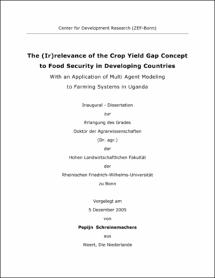Schreinemachers, Pepijn: The (Ir)relevance of the Crop Yield Gap Concept to Food Security in Developing Countries : With an Application of Multi Agent Modeling to Farming Systems in Uganda. - Bonn, 2006. - Dissertation, Rheinische Friedrich-Wilhelms-Universität Bonn.
Online-Ausgabe in bonndoc: https://nbn-resolving.org/urn:nbn:de:hbz:5N-07779
Online-Ausgabe in bonndoc: https://nbn-resolving.org/urn:nbn:de:hbz:5N-07779
@phdthesis{handle:20.500.11811/2368,
urn: https://nbn-resolving.org/urn:nbn:de:hbz:5N-07779,
author = {{Pepijn Schreinemachers}},
title = {The (Ir)relevance of the Crop Yield Gap Concept to Food Security in Developing Countries : With an Application of Multi Agent Modeling to Farming Systems in Uganda},
school = {Rheinische Friedrich-Wilhelms-Universität Bonn},
year = 2006,
note = {This thesis scrutinizes the relationship between the width of the crop yield gap and farm household food security. Many researchers have argued that an exploitable gap between average crop yields and the genetic yield potential contributes to food security and that this potential should therefore be improved. Yet, crop yield gaps in developing countries are mostly wide, which is prima facie evidence that factors other than the yield potential are most constraining. A significant negative correlation between the width of the rice yield gap and food security for 19 Indian states confirms this.
The concept and pitfalls of the crop yield gaps are further analyzed at the farm household level for the case of improved maize in two village communities in southeast Uganda. Multi-agent systems are used to model the heterogeneity in socioeconomic and biophysical conditions. The model integrates three components: (1) whole farm mathematical programming models representing human decision-making; (2) spatial layers of different soil properties representing the physical landscape; and (3) a biophysical model simulating crop yields and soil property dynamics. The thesis contributes to methodology in four ways: First, it is shown that MAS can be parameterized empirically from farm survey data. Second, it develops a non-separable three-stage decision model of investment, production, and consumption to capture economic trade-offs in the allocation of scarce resources over time. Third, a three-step budgeting system, including an Almost Ideal Demand System, is used to simulate poverty dynamics. Fourth, coping strategies to food insecurity are included.
Simulation results show that neither the width of the yield gap nor the change in its width over time relate to food security at the farm household level. The maize yield gap is decomposed in both proximate and underlying factors. It is shown that the existence of maize yield gaps does not signal inefficiencies but poverty can be reduced substantially by addressing the underlying constraints such as access to innovations and credit. Improvements in labor productivity are crucial and are a much better indicator of development than crop yields and yield gaps. The results suggest that a strong focus on crop yields and yield gaps might not only be inefficient but even counterproductive to development.},
url = {https://hdl.handle.net/20.500.11811/2368}
}
urn: https://nbn-resolving.org/urn:nbn:de:hbz:5N-07779,
author = {{Pepijn Schreinemachers}},
title = {The (Ir)relevance of the Crop Yield Gap Concept to Food Security in Developing Countries : With an Application of Multi Agent Modeling to Farming Systems in Uganda},
school = {Rheinische Friedrich-Wilhelms-Universität Bonn},
year = 2006,
note = {This thesis scrutinizes the relationship between the width of the crop yield gap and farm household food security. Many researchers have argued that an exploitable gap between average crop yields and the genetic yield potential contributes to food security and that this potential should therefore be improved. Yet, crop yield gaps in developing countries are mostly wide, which is prima facie evidence that factors other than the yield potential are most constraining. A significant negative correlation between the width of the rice yield gap and food security for 19 Indian states confirms this.
The concept and pitfalls of the crop yield gaps are further analyzed at the farm household level for the case of improved maize in two village communities in southeast Uganda. Multi-agent systems are used to model the heterogeneity in socioeconomic and biophysical conditions. The model integrates three components: (1) whole farm mathematical programming models representing human decision-making; (2) spatial layers of different soil properties representing the physical landscape; and (3) a biophysical model simulating crop yields and soil property dynamics. The thesis contributes to methodology in four ways: First, it is shown that MAS can be parameterized empirically from farm survey data. Second, it develops a non-separable three-stage decision model of investment, production, and consumption to capture economic trade-offs in the allocation of scarce resources over time. Third, a three-step budgeting system, including an Almost Ideal Demand System, is used to simulate poverty dynamics. Fourth, coping strategies to food insecurity are included.
Simulation results show that neither the width of the yield gap nor the change in its width over time relate to food security at the farm household level. The maize yield gap is decomposed in both proximate and underlying factors. It is shown that the existence of maize yield gaps does not signal inefficiencies but poverty can be reduced substantially by addressing the underlying constraints such as access to innovations and credit. Improvements in labor productivity are crucial and are a much better indicator of development than crop yields and yield gaps. The results suggest that a strong focus on crop yields and yield gaps might not only be inefficient but even counterproductive to development.},
url = {https://hdl.handle.net/20.500.11811/2368}
}






